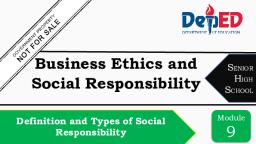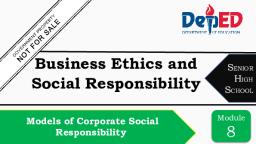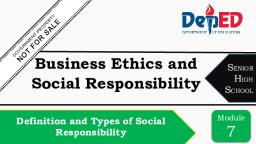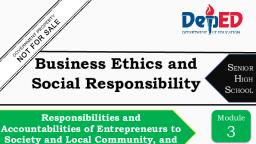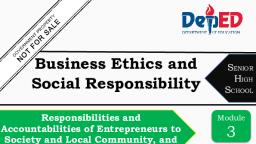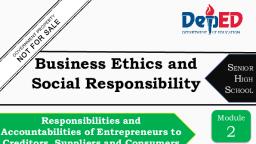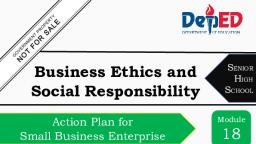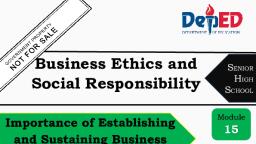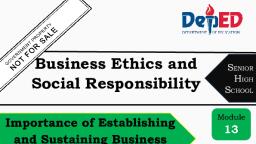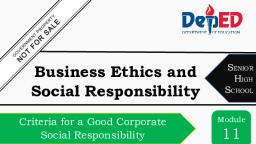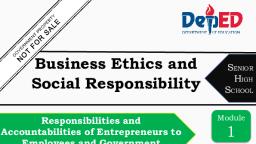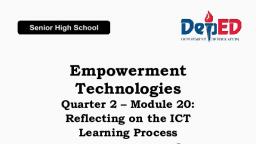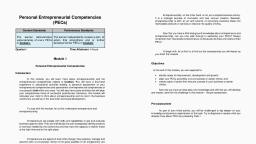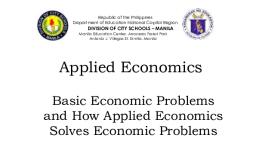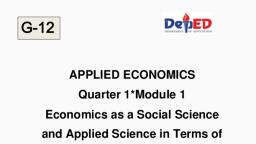Page 1 :
Business Ethics and, Social Responsibility, Formulate a Morally Defensible, Position on Ethical Issues in, Entrepreneurship, , Business Ethics and Social Responsibility, , SENIOR, HIGH, SCHOOL, Module, , 6, Quarter 4
Page 2 :
Business Ethics and Social Responsibility- Grade 12, Quarter 4 – Module 6: Formulate a Morally Defensible Position on Ethical, Issues in Entrepreneurship, First Edition, 2020, Republic Act 8293, Section 176 states that no copyright shall subsist, in any work of the Government of the Philippines. However, prior approval of, the government agency or office wherein the work is created shall be necessary, for the exploitation of such work for a profit. Such agency or office may, among, other things, impose as a condition the payment of royalties., Borrowed materials (i.e., songs, stories, poems, pictures, photos, brand, names, trademarks, etc.) included in this module are owned by their respective, copyright holders. Every effort has been exerted to locate and seek permission, to use these materials from their respective copyright owners. The publisher, and authors do not represent nor claim ownership over them., Published by the Department of Education - Schools Division of Pasig, City, Development Team of the Self-Learning Module, Writer: Anna lyn A. Pintes, Content/Language Validator: Dennis T. Alex, Edna D. Camarao, Reviewers: Hedelita B. Calonia, Cheska Telan, Eunice H. Mariposque, Dennis T. Alex, Edna D. Camarao, Illustrator: Name, Layout Artist:Name, Management Team:, , Ma. Evalou Concepcion A. Agustin, OIC-Schools Division Superintendent, Carolina T. Rivera, EdD, OIC-Assistant Schools Division Superintendent, Victor M. Javeña EdD, Chief, School Governance and Operations Division and, Manuel A. Laguerta EdD, Chief, Curriculum Implementation Division, , Education Program Supervisors, Librada L. Agon EdD(EPP/TLE/TVL/TVE), Liza A. Alvarez(Science/STEM/SSP), Bernard R. Balitao(AP/HUMSS), Joselito E. Calios (English/SPFL/GAS), Norlyn D. Conde EdD(MAPEH/SPA/SPS/HOPE/A&D/Sports), Wilma Q. Del Rosario (LRMS/ADM), Ma. Teresita E. HerreraEdD(Filipino/GAS/Piling Larang), Perlita M. IgnacioPhD(EsP), Dulce O. Santos PhD(Kindergarten/MTB-MLE), Teresita P. TagulaoEdD(Mathematics/ABM), , Printed in the Philippines by the Department of Education – Schools, Division of Pasig City
Page 3 :
Business Ethics, and Social, Responsibility, , SENIOR, HIGH, SCHOOL, Module, , 6, Quarter 4, , Formulate a Morally Defensible, Position on Ethical Issues in, Entrepreneurship
Page 4 :
Introductory Message, For the Facilitator:, Welcome to the Senior High School – on Formulate a Morally Defensible, Position on Ethical Issues in Entrepreneurship!, This Self-Learning Module was collaboratively designed, developed, and, reviewed by educators from the Schools Division Office of Pasig City headed by, its Officer-in-Charge Schools Division Superintendent, Ma. Evalou Concepcion, A. Agustin, in partnership with the City Government of Pasig through its, mayor, Honorable Victor Ma. Regis N. Sotto. The writers utilized the standards, set by the K to 12 Curriculum using the Most Essential Learning Competencies, (MELC)in developing this instructional resource., This learning material hopes to engage the learners in guided and, independent learning activities at their own pace and time. Further, this also, aims to help learners acquire the needed 21st - century skills especially the 5, Cs, namely: Communication, Collaboration, Creativity, Critical Thinking, and, Character while taking into consideration their needs and circumstances., In addition to the material in the main text, you will also see this box in, the body of the module:, , Notes to the Teacher, This contains helpful tips or strategies that, will help you in guiding the learners., , As a facilitator, you are expected to orient the learners on how to use, this module. You also need to keep track of the learners' progress while, allowing them to manage their learning. Moreover, you are expected to, encourage and assist the learners as they do the tasks included in the module.
Page 5 :
For the Learner:, Welcome to the Business Ethics and Social Responsibility Self-Learning Module, on Formulate a Morally Defensible Position on Ethical Issues in, Entrepreneurship!, This module was designed to provide you with fun and meaningful, opportunities for guided and independent learning at your own pace and time., You will be enabled to process the contents of the learning material while being, an active learner., This module has the following parts and corresponding icons:, , Expectations – This points to the set of knowledge and, skills that you will learn after completing the module., Pretest - This measures your prior knowledge about the, lesson at hand., Recap - This part of the module provides a review of, concepts and skills that you already know about a previous, lesson., , Lesson- This section discusses the topic in the module., , Activities - This is a set of activities that you need to, perform., , Wrap-Up- This section summarizes the concepts and, application of the lesson., Valuing- This part integrates a desirable moral value in the, lesson., Post test - This measures how much you have learned, from the entire module.
Page 6 :
EXPECTATIONS, After going through this module, you are expected to:, 1. define problem solving in the context of entrepreneurship;, 2. describe and compare the adaptive model and the, innovative model of problem solving;, 3. identify the skills of entrepreneurs need for effective, problem solving, , PRETEST, Directions: Identify the correct answer. Write the answer on your, answer sheet., ____________________1. It seeks solutions for problems in ways that are, tested and known to be effective, ____________________2. It uses techniques that are unknown to the, market and that bring advantage to an organization., ____________________3. It is the complex analysis of a problem or issue, with the goal of solving the problem or making a decision., ____________________4. There are certain skills that entrepreneurs, possess that make them particularly good problem solvers., ____________________5. It is the ability to communicate messages, effectively to an intended recipient., , RECAP, At the last meeting, we discussed on how to develop a workplace, culture of ethical excellence and accountability., Now, in this module, we will discuss the problem solving to find
Page 7 :
entrepreneurial solutions., But before we proceed, I want you to discuss on how to develop, the foundation and framework of an ethically responsible organization., , LESSON, Two Problem Solving Models: Adaptive and Innovative, There, , are, , two, , prominent, , models: adaptive and innovative., Michael Kirton,, , developed, , A, , established, renowned, , the Kirton, , problem-solving, , British, , psychologist,, , Adaption-Innovation, , (KAI), , Inventory to measure an individual’s style of problem solving. Problemsolving preferences are dependent on the personality characteristics of, originality, conformity, and efficiency, according to Kirton. The KAI, inventory, , identifies, , an, , individual’s, , problem-solving, , approach, , by, , measuring agreement with statements that align with characteristics,, such as the ability to produce many novel ideas, to follow rules and get, along in groups, and to systematically orient daily behavior. The results, categorize an individual as an innovator or an adapter. Innovators are, highly original, do not like to conform, and value efficiency less than, adapter., The first and more conservative approach an entrepreneur may use to, solve problems is the adaptive model. The adaptive model seeks, solutions for problems in ways that are tested and known to be effective., An adaptive model accepts the problem definition and is concerned with, resolving problems rather than finding them. This approach seeks, greater efficiency while aiming at continuity and stability. The second, and more creative approach is the innovative model of entrepreneurial
Page 8 :
problem solving, which uses techniques that are unknown to the market, and that bring advantage to an organization., , Problem-Solving Skills, While identifying problems is a necessary part of the origin of the, entrepreneurial process, managing problems is an entirely different, aspect once a venture is off the ground and running. An entrepreneur, does not have the luxury of avoiding problems and is often responsible, for all problem solving in a startup or other form of business. There are, certain skills that entrepreneurs possess that make them particularly, good problem solvers., Critical Thinking, Critical thinking is the complex analysis of a problem or issue with the, goal of solving the problem or making a decision. The entrepreneur, analyzes and peels away the layers of a problem to find the core of an, issue facing a business. The entrepreneur focuses on the heart of the, problem and responds reasonably and openly to suggestions for solving, it. Critical, Communication, Communication skills, the ability to communicate messages effectively to, an intended recipient, are the skills entrepreneurs use to pool resources, for the purposes of investigating solutions leading to innovative problem, solving and competitive advantage. Good communication allows for the, free association of ideas between entrepreneurs and businesses., Decisiveness, Is as it sounds: the ability to make a quick, effective decision, not letting, too much time go by in the process. Entrepreneurs must be productive,, even in the face of risk. They often rely on intuition as well as on hard
Page 9 :
facts in making a choice. They ask what problem needs to be solved,, think about solutions, and then consider the means necessary to, implement an idea. And the decisions must be informed with research., Ability to Analyze Data, Data analysis is the process of analyzing data and modeling it into a, structure, , that, , leads, , to, , innovative, , conclusions. Identifying, , Entrepreneurial Opportunity covered much of the sources of data that, entrepreneurs might seek. But it is one thing to amass information and, statistics. It is another to make sense of that data, to use it to fill a, market need or forecast a trend to come. Successful founders know how, to pose questions about and make meaning out of information. And if, they can’t do that themselves, they know how to bring in experts who, can., , Understanding of Business and Industry, Entrepreneurs need sound understanding of markets and industries., Often times, they are already working in a large organization when they, see growth opportunities or inefficiencies in a market. The employee, gains a deep understanding of the industry at hand. If the employee, considers a possible solution for a problem, this solution might become, the basis for a new business., , Resourcefulness, Resourcefulness is the ability to discover clever solutions to obstacles., Sherrie Campbell, a psychologist, author, and frequent contributor, to Entrepreneur magazine on business topics, put it this way: “There is, not a more useful or important trait to possess than resourcefulness in, the pursuit of success. Resourcefulness is a mindset, and is especially, relevant when the goals you have set are difficult to achieve or you, cannot envision a clear path to get to where you desire to go.
Page 10 :
Types of Problem Solvers, Entrepreneurs have an insatiable appetite for problem solving. This drive, motivates them to find a resolution when a gap in a product or service, occurs. They recognize opportunities and take advantage of them. There, are several types of entrepreneurial problem solvers, including selfregulators, theorists, and petitioners., Self-Regulating Problem Solvers, Self-regulating problem solvers are autonomous and work on their own, without external influence. They have the ability to see a problem,, visualize a possible solution to the problem, and seek to devise a, solution. The solution may be a risk, but a self-regulating problem solver, will recognize, evaluate, and mitigate the risk. For example, an, entrepreneur has programmed a computerized process for a client, but, in testing it, finds the program continually falls into a loop, meaning it, gets stuck in a cycle and doesn’t progress. Rather than wait for the, client to find the problem, the entrepreneur searches the code for the, error causing the loop, immediately edits it, and delivers the corrected, program to the customer. There is immediate analysis, immediate, correction, and immediate implementation. The self-regulating problem, solvers’ biggest competitive advantage is the speed with which they, recognize and provide solutions to problems., Theorist Problem Solvers, Theorist problem solvers see a problem and begin to consider a path, toward solving the problem using a theory. Theorist problem solvers are, process oriented and systematic. While managers may start with a, problem and focus on an outcome with little consideration of a means to, an end, entrepreneurs may see a problem and begin to build a path with, what is known, a theory, toward an outcome. That is, the entrepreneur, proceeds through the steps to solve the problem and then builds on the
Page 11 :
successes, rejects the failures, and works toward the outcome by, experimenting and building on known results. At this point, the problem, solver may not know the outcome, but a solution will arise as, experiments toward a solution occur., Petitioner Problem Solvers, Petitioner problem solvers see a problem and ask others for solution, ideas. This entrepreneur likes to consult a person who has “been there, and done that.” The petitioner might also prefer to solve the problem in a, team environment. Petitioning the entrepreneurial team for input, ensures that the entrepreneur is on a consensus-driven path. This type, of problem solving takes the, , longest, , to, , complete because, , the, , entrepreneur must engage in a democratic process that allows all, members on the team to have input. The process involves exploration of, alternatives for the ultimate solution., In summary, there is no right or wrong style of problem solving; each, problem solver must rely on the instincts that best drive innovation., Further, they must remember that not all problem-solving methods work, in every situation. They must be willing to adapt their own preference to, the situation to maximize efficiency and ensure they find an effective, solution. Attempting to force a problem-solving style may prevent an, organization, , from, , entrepreneurial, , finding, , the, , problem-solving, , best, skills, , solution., such, , as, , While, critical, , general, thinking,, , decisiveness, communication, and the ability to analyze data will likely, be used on a regular basis in your life and entrepreneurial journey,, other problem-solving skills and the approach you take will depend on, the problem as it arises.
Page 12 :
ACTIVITIES, As a student, if you are given a chance to be a young entrepreneur,, which of the two problem solving models, you are going to apply in, facing today’s pandemic situation?, , WRAP-UP, Let’s wrap up by answering the following questions:, 1. Which method do you think applies more to entrepreneurship, the, innovative or adaptive problem-solving method? Do you see yourself, as using one method more than the other in your entrepreneurial, endeavors? If so, which one and why?, 2. Do you think it is important for the entrepreneur to understand and, develop all the problem-solving skills to manage a successful, startup? Why or why not?, , VALUING, 1. What is the relationship between entrepreneurial thinking and, problem solving?, 2. What are the key aspects of the two types of problem-solving methods, the entrepreneur uses to problem solve?
Page 13 :
POST TEST, Directions: Choose the letter of the best answer. Write the answer on, your answer sheet., 1. It is the ability to make a quick, effective decision, not letting too, much time go by in the process., A. Decision, B. Decisiveness, C. Expressiveness, 2. It is the process of analyzing data and modeling it into a structure, that leads to innovative conclusions., A. Data analysis, B. Conclusion, C. Recommendation, 3. It is the ability to discover clever solutions to obstacles., A. Critical Thinking, B. Problem Solving Skills, C. Resourcefulness, 4. It uses techniques that are unknown to the market and that bring, advantage to an organization., A. Innovative Model, B. Captive Model, C. Passive Model, 5. It is a psychologist, author, and frequent contributor to Entrepreneur, magazine on business topics, put it this way: “There is not a more, useful or important trait to possess than resourcefulness in the, pursuit of success., A. Sherry Campbell, B. Cherrie Campbell, C. Sherie Campbell
Page 14 :
KEY TO CORRECTION, EXPECTATIONS, PRE -TEST, , POST-TEST, , 1., 2., 3., 4., , 1., 2., 3., 4., 5., , Adaptive Model, Innovative Model, Critical Thinking, Problem Solving, Skills, 5. Good, Communication, , B, A, C, A, A, , References, Racelis, Aliza. Business Ethics and Social Responsibility. Manila: Rex, Book Store, 2017., “Ch. 1 Introduction - Entrepreneurship.” OpenStax,, openstax.org/books/entrepreneurship/pages/1-introduction., “Ch. 2 Suggested Resources - Entrepreneurship.” OpenStax,, openstax.org/books/entrepreneurship/pages/2-suggestedresources.

